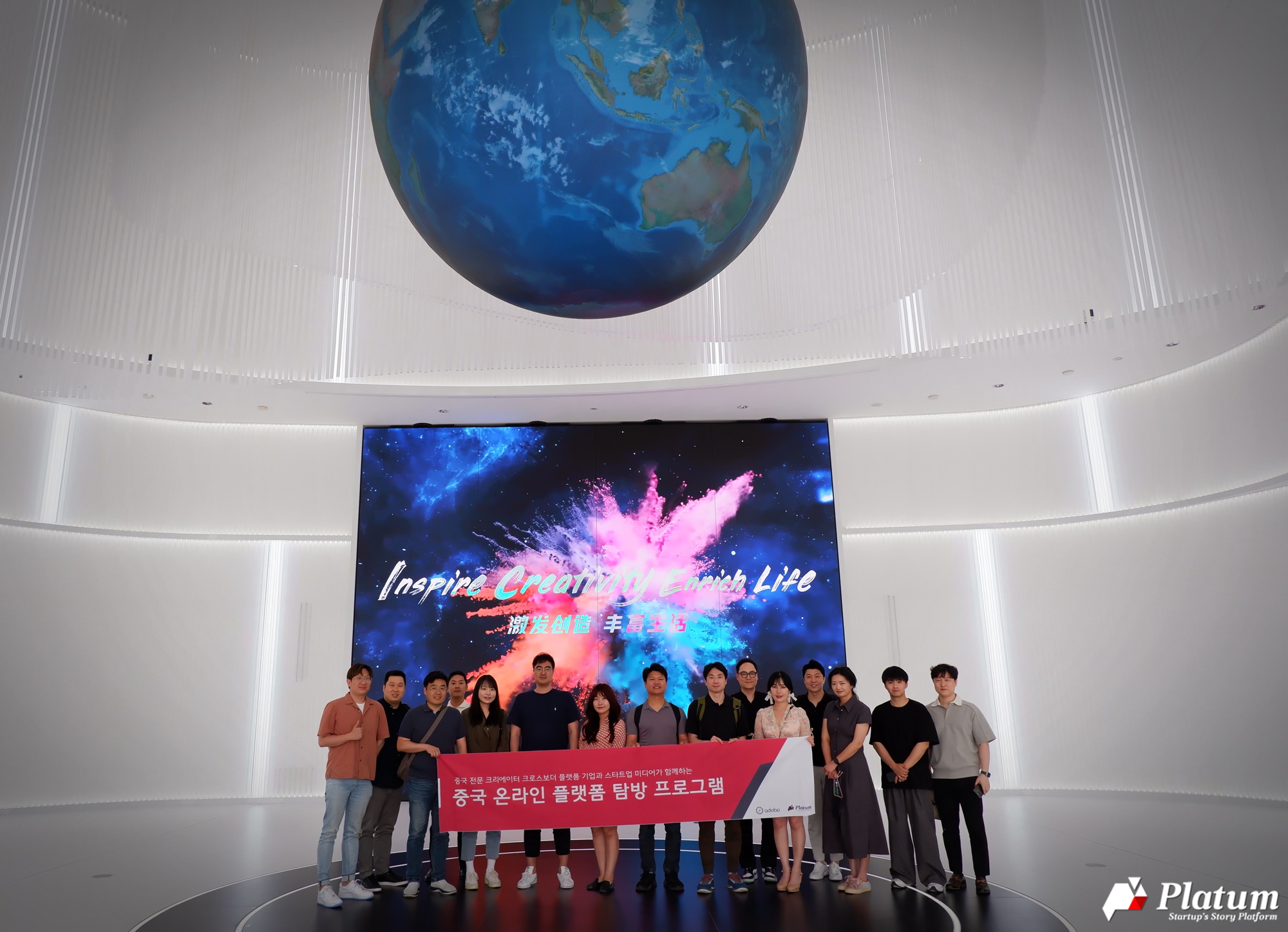
Not just in Korea, but globally, 1020s tend to get their fun and curiosity from video platforms, not portals or TV. In other words, the online starting point for Gen Z is not a portal, but a video platform. It’s also worth noting that video creators have been at the top of teens’ career aspirations for years.
The media industry has also changed. It’s no longer uncommon to see creators who made their name on video platforms making the leap to broadcast, or celebrities launching their own channels. They create what they want to show, what their fans want to see, and show it quickly, without waiting for a broadcaster to program it. This is partly due to the freedom of the creative environment. It’s also not a silent echo. Fans and subscribers respond immediately to raw content. It’s a way to communicate, but it can also end up being a branding tool. Depending on the number of subscribers and views, it can even lead to monetary income.
On the morning of May 9, about 20 Koreans gathered in the departure hall of Beijing International Airport. They were representatives of media startups, venture capitalists, creators, and other companies in the video industry. The reason for their meeting in China is to participate in a business trip to explore Chinese online platforms.
It was unusual to accompany people from outside the same company or industry for business insights, but there is a demand for overseas company visits in Korea. At one time, South Korean companies often tried to link their software with hardware companies in Shenzhen, Guangdong, China.
The purpose of the company tour is to understand the Chinese “online platform” environment. Over the course of four days from September 9 to 12, the group visited leading companies in China’s online platform industry, including personalized news service app ‘TouTiao’, global short video platform app “Tik Tok”, operator ‘ByteDance’, China’s largest OTT platform ‘iQIYI’, and live and online commerce platforms ‘Xiaohongshu’, ‘Weibo’, and ‘Baidu’.
In China, the popularity of YouTube is a different story. In an environment where YouTube has been blocked by other players, a myriad of indigenous platforms have emerged to compete. It’s another world where dozens of middle-form platforms like YouTube coexist, with an average MAU of 150 million. That’s why it’s considered a market of opportunity for local and international video creators.
“We designed the program with a focus on helping Korean media companies and practitioners create a roadmap for practical strategies,” said Junhan J. Ahn, CEO of Adoba, who organized the business trip. He also said, “We wanted the participants to understand the current situation through first-hand reports.”
He advised creators to use a variety of platforms. “It doesn’t make sense to look at just one platform, YouTube,” Ahn said. The ideal approach is to distribute your content across multiple platforms on a continent with over 500 million viewers. If you think of it as an extension, not an alternative, it becomes more accessible. It’s not about abandoning YouTube, it’s about expanding to more platforms. That’s what this program is all about.
Adoba, a Korean startup that provides globalization solutions for creators, was founded in 2018 by Ahn. The flagship service is “Adobaro”, which aims to solve the challenges that foreign creators face when entering overseas platforms such as China. It features a fast track from a technology perspective, allowing creators to take the lead in all necessary tasks, from channel opening to revenue settlement.
At the end of the four-day trip, participants appreciated the opportunity to visit Chinese platform companies and get a first-hand look at their operations. “It was meaningful to understand the media environment in China and receive briefings from local companies. In addition, it was a great opportunity to visit different media platform companies to understand the fierce competition in Chinese media and realize that there are opportunities for us,” said a startup representative.
Another company representative said, “In a prolonged economic downturn, staying in the domestic market is tantamount to being left behind. China’s online platforms are a clear opportunity for media companies like ours to grow.” He also said, “There is a bias against China. There’s a perception that you can’t ignore a huge market, but because it’s China, it’s risky. In fact, there are a lot of restrictions on foreign companies distributing and monetizing content here. However, through this program, we have been introduced to different methods. We plan to build our future strategy around that.”
Currently, the buzzwords in the Chinese online platform industry are “living with Covid-19” and “lifting the government ban on Hallyu”. This is because China’s “Zero Corona” policy has opened doors that have been tightly closed for the past three years. After the quarantine was lifted last year, even PCR testing was abolished at the end of April this year. Business experts expect the Chinese online platform industry to boom again in the coming years. With the resumption of courier and delivery services, various online services, including social networks and video platforms that focus on commerce, are expected to attract consumers again.
Here’s a look at the Chinese online platform companies the group visited.

ByteDance(字节跳动)
ByteDance (字节跳动) is a Chinese IT company providing mobile and Internet services. It is best known for its global short-form video platform TikTok (‘Douyin (抖音)’ in China). TikTok is recognized for its ability to tap into Gen Z’s demand for short-form video and currently leads all media platforms in time spent per person.
First launched in September 2016, TikTok launched its global version in May 2017 and reached over 100 million global subscribers in just 12 months. This is remarkably fast considering that it took Facebook 54 months, Twitter 49 months, and Instagram 28 months to reach 100 million users. Since then, the number of users has continued to grow, and by 2022, TikTok’s cumulative users in China reached approximately 840 million, with over 700 million daily active users (DAUs). The company is still privately held and does not disclose its exact revenue, but according to leaked TikTok financial statements reported by various Chinese media outlets, the company’s revenue in 2021 was $61.7 billion, up nearly 80% year-over-year. TikTok is already the third largest internet company in China by revenue, behind Alibaba and Tencent.
ByteDance’s first product to make a name for itself was TouTiao(今日头条), which translates to “Today’s Headlines”. The service, which uses artificial intelligence (AI) technology to analyze users’ news consumption patterns and deliver personalized news, was a huge hit with Chinese mobile users who felt overwhelmed by information overload. At the end of last year, TouTiao had 710 million subscribers.
ByteDance’s presence on TikTok is global. TikTok is a global service currently available in over 150 countries. TikTok has over 1 billion monthly active users this year, with over 150 million in the US alone. Time spent on TikTok is much higher than on other platforms. Compared to YouTube (74 minutes), Instagram (51 minutes) and Facebook (49 minutes), the average daily usage of TikTok is nearly 95 minutes.
In 2022, the gross merchandise value (GMV) generated by TikTok was CNY1.38 trillion ($197.7 billion). It took Alibaba and JD.com, two of China’s online shopping leaders, more than a decade to reach CNY1 trillion ($143.3 billion) in annual GMV, and PDD of about 5 years.
ByteDance also operates the video sharing service ‘Xigua Video (西瓜视频)’. It was originally a video production section of TouTiao under the name ‘TouTiao Video,’ but was later spun off and has been in operation ever since. Today, it has grown to the point where it has been called China’s YouTube and even produces original content.
ByteDance is headquartered in Haidian District, Beijing with offices in Seoul, LA, Silicon Valley, New York, London, Paris, Berlin, Dubai, Toronto, Singapore, Jakarta and Tokyo.

Kuaishou (快手)
In business, you don’t remember second place. But it’s worth remembering Kuaishou (快手), which came in second to first-place ByteDance.
Kuaishou is the second most used short-form video platform in China after TikTok. As of Q3 2021, it has 320.4 million average daily users and 572.9 million average monthly users.
Kuaishou started as a GIF (Graphics Interchange Format) creation application in March 2011, and turned into a short clip platform in July 2013. It is classified as a Tencent-affiliated platform after receiving a large investment from Tencent, and is a rival platform to the Chinese version of TikTok, Douyin.
Kuaishou made a spectacular debut on the Hong Kong Stock Exchange in 2021. Kuaishou reportedly raised HK$42 billion ($5.32 billion) in its IPO. This was the second-largest IPO in Hong Kong’s history, behind Alibaba’s secondary listing in November 2019, which raised $13 billion.
Kuaishou claims to be a best friend culture (老铁文化), so it is a platform characterized by a close relationship between creators and viewers. While Douyin focuses on trend-setting influencers, Kuaishou users are more oriented toward ordinary people. They are mainly located in third- and fourth-tier cities and focus on representing Chinese society. This approach makes sense considering that only 7% of China’s population lives in first-tier cities, while 93% live in second- and third-tier cities.
To support this, Kuaishou defines the core of its recommendation algorithm as “understanding”. Understanding the characteristics of content, understanding the characteristics of people, and the historical interactions between people and content as a model to predict the match between content and users. The content characteristics that reflect Kuaishou’s user base include slow and lyrical scenes, ordinary daily life, rural life, nature and people, and these characteristics are gradually changing as young people gradually enter the market, and they are also gradually mixing with the characteristics of Douyin.
What’s remarkable is that Kuaishou, which led the way in live commerce by focusing on cheap and good products for these ordinary people, has surpassed Douyin in sales volume. Economies of scale seem to be working here as well.

iQIYI (爱奇艺)
iQIYI (爱奇艺) is China’s leading OTT service. It is currently one of the largest online video sites in the world, with nearly 6 billion hours of service usage per month and more than 500 million monthly active users.
Emphasizing the concept of paid VIP membership under the banner of ‘light luxury’, iQIYI has grown by offering premium content, high-end audio-visual experiences and unique offline membership services exclusively for VIP members.
iQIYI is a NASDAQ-listed company with a market capitalization of approximately $7 billion. It was founded with investment from Baidu and is now a subsidiary of Baidu. In addition to being the number one OTT provider in China, iQIYI also has content production capabilities, including entertainment and drama.
iQIYI has been called the Chinese version of Netflix. Initially, it mainly provided a replay service, but in 2017, it increased the proportion of self-produced content and began exporting overseas as its quality was recognized. It sources a variety of VR content from China and around the world, and provides it with dedicated VR devices. In 2018, at the Single’s Day ((光棍節): Chinese version of Black Friday) event in 2018, we ranked first in both sales volume and sales value, creating a success story for our device + content package.
iQIYI serves as a bridgehead to China for overseas media companies that cannot enter the country directly due to Chinese government sanctions. Among OTT platforms, iQIYI has the most interest in Korean content and the Korean market, and has not only distributed content but also entered the Korean market directly, such as exclusively supplying the dramas “My Love from the Stars” and “Descendants of the Sun” to the Chinese market.

Baidu(百度)
Baidu (百度) is the world’s largest Chinese-language search engine and portal site. With more than 700 million users, Baidu has a 70% search market share in China. Baidu was established in January 2000 by two founders in Zhongguancun High-tech Zone (中關村), Beijing, with the purpose of “simple and reliable website”.
Baidu is one of China’s three largest IT companies, along with Alibaba and Tencent. They are collectively known as “BAT” after their initials. Like Google, Baidu derives most of its revenue from advertising, displaying keyword and brand ads at the top of search pages, as well as banner ads. It also has the technology to partner with advertisers to show personalized content to users.
Baidu is also considered the most advanced company in autonomous driving technology in China. Baidu’s ACE Traffic Engine smart transportation solution has now been deployed in 63 cities, 12 more than last quarter, and has been applied in cities such as Beijing, Guangzhou, Changsha and Chongqing, greatly improving transportation efficiency. Baidu will also launch its own smartphone this month. It will be the first major Chinese tech company to produce a smartphone.
Baidu is also actively promoting its entry into the video industry. One example is the medium-length video platform Haokan Video (好看视频). Haokan Video has grown rapidly thanks to Baidu’s massive search traffic. It also uses Baidu’s AI to improve user satisfaction through content recommendations. Because it can be linked to Baidu search, it features a large number of channel entries from organizations and brands. It is a platform that can be used for both brand promotion and search results.

Sina(新浪)
Sina (新浪), known as Weibo, the Chinese version of Twitter, is a first-generation online company. It was founded on November 30, 1998 as a search service, and Sina Weibo has served in August 2009. Several companies launched Weibo services to compete, but Sina was the winner.
Weibo is a social media platform based on user relationships, characterized by rapid information exchange, public opinion generation, and dissemination based on celebrity fandom culture. Weibo’s recommendation mechanism uses related tags, geography, and discussion topics to guide users. Celebrity and brand marketing makes the best use of these characteristics, and the official pages of celebrity fan clubs and brands with a presence in China, both domestically and globally, are often the first to be created on Weibo.
Authenticated celebrities and brands provide V-verification to prevent impersonation by the public. After focusing mainly on text and images, the company is actively investing in video content and creators to meet the trend of video consumption.








댓글 남기기